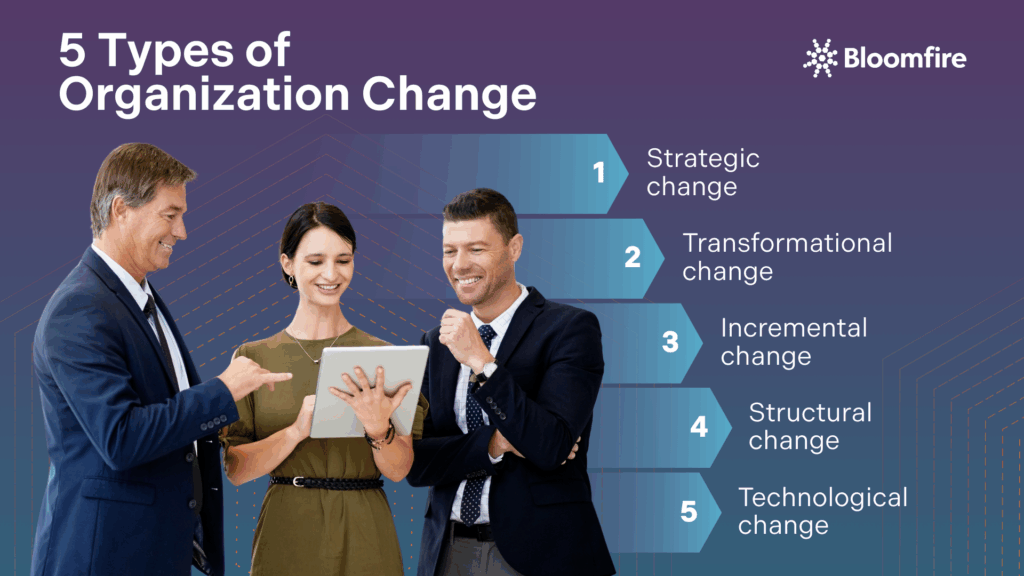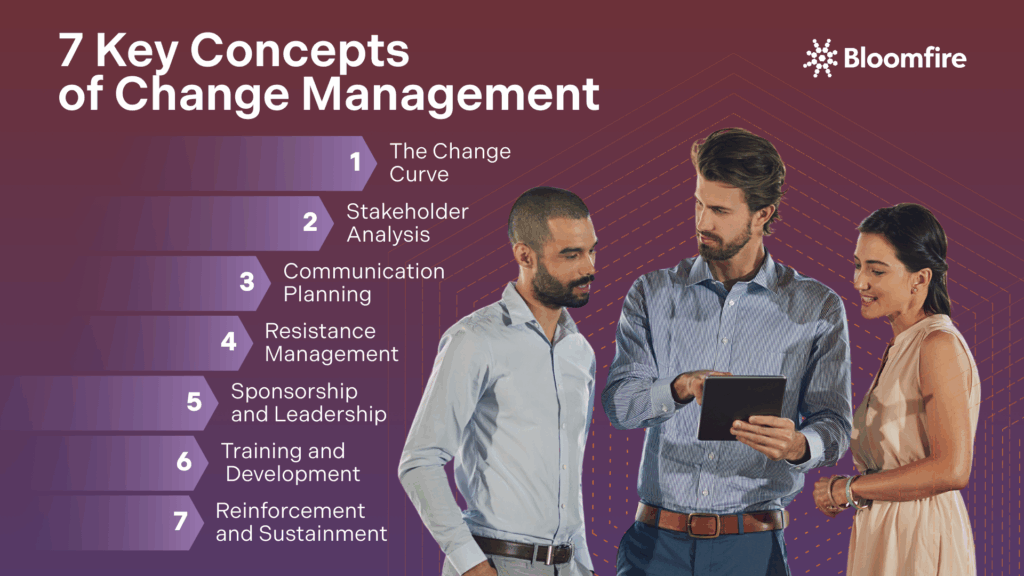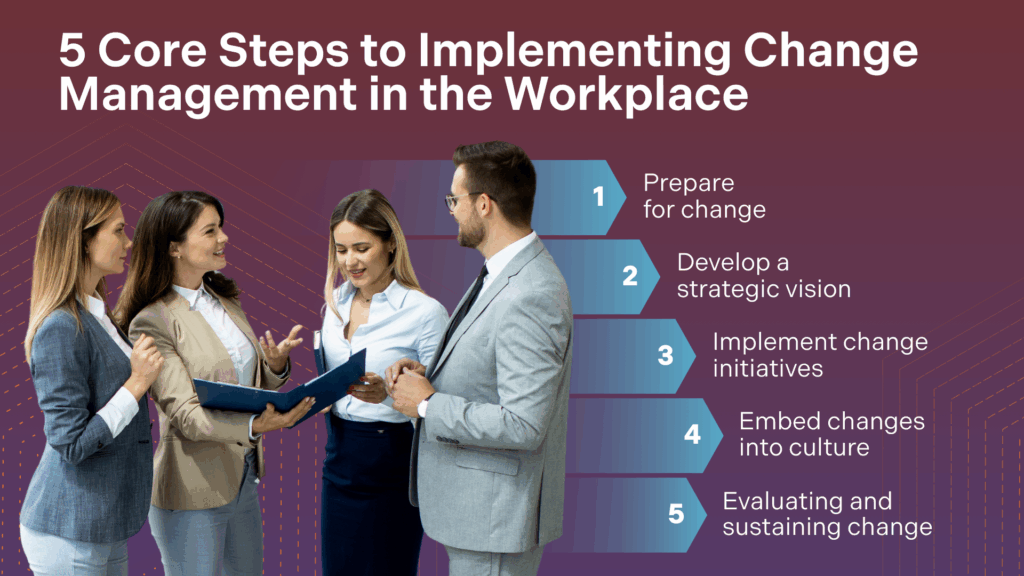What Is Change Management? Definition, Key Concepts, & Models

Highlights
- Change management is the art and science of navigating organizational transitions by focusing on the human element.
- Successful organizational change requires strategically navigating human reactions, engaging stakeholders, communicating clearly, addressing resistance, securing leadership support, providing necessary training, and ensuring sustained adoption.
- Change management models, such as Kotter’s 8-Step, ADKAR, Prosci’s 3-Phase, Lewin’s, and McKinsey 7-S, offer structured approaches to guiding organizations through transitions.
When a company restructures, launches a new technology, or merges with another organization, change management becomes indispensable. These moments of significant transition demand a system to guide employees and ensure the initiative’s success. Without it, companies risk widespread resistance, decreased productivity, and, ultimately, the failure of the change itself.
Below, we explore what change management is, its key concepts, and known models. Learn how it transforms potential chaos into a strategic advantage.
What Is Organizational Change Management?
Change management is a systematized approach that guides organizations and their people through transitions. It focuses on the people side of change and ensures employees understand, accept, and embrace new processes, technologies, or organizational structures.
Effective organizational change management yields numerous benefits. It can significantly increase employee engagement and morale by addressing concerns and providing support during transitions. It can also reduce resistance to change, leading to smoother implementations and improved project success rates.
Why Change Management Matters to Organizations
Change management ensures a smooth transition from the present operational state to a beneficial future state while minimizing disruption. The focus is on proactively addressing the human element of change, which covers the adjustments in processes, jobs, and mindsets required of employees, to prevent resistance and maintain operational continuity.
Failing to manage this transition effectively can lead to delays, budget overruns, and low adoption. These consequences can derail even the most strategically sound initiatives.
Additionally, effective enterprise change management is the foundation for sustained success and driving high employee engagement. When employees are actively involved and understand the necessity and benefits of the change, it fosters a sense of ownership and commitment. This involvement helps secure long-term benefits, such as improved productivity and morale.
What Are the Types of Organizational Change?
Understanding the different categories of organizational change is essential for effective change management. The scope, speed, and depth of a change initiative determine the most appropriate strategy for communication, training, and stakeholder involvement.
Guiding an organization from its current state to a desired future state requires correctly diagnosing the type of change being undertaken. That way, leaders can tailor their approach to ensure successful implementation and minimize employee disruption.

1. Strategic change
Strategic changes involve significant, high-level adjustments to an organization’s long-term policies, structure, or overall business model. These changes are often proactive, aimed at dramatically improving competitive advantage, or at fundamentally responding to major shifts in the market or regulatory environment.
Example: A major retail company decides to completely shift its focus from brick-and-mortar stores to a primarily e-commerce model and closes 50% of its physical locations. This involves new policies for online logistics, a change in investment strategy, and restructuring key departments.
2. Transformational change
Transformational change represents a complete and fundamental overhaul of the existing practices, core processes, and governance across the entire organization. This type of change often requires a deep, simultaneous shift in organizational culture and the underlying values that drive employee behavior. It is typically driven by the existential need to adapt to major industry disruptions, economic crises, or revolutionary technological advancements.
Example: A decades-old manufacturing company adopts the principles of ‘Agile’ and ‘Lean’ methodologies across all departments—from production and HR to sales—requiring employees to move from rigid, siloed processes to cross-functional, collaborative, and iterative teams.
3. Incremental change
Incremental changes occur gradually and are less disruptive to daily operations. They focus on continuous, small-scale improvements over time, allowing organizations to fine-tune processes and maintain efficiency without overwhelming employees. This measured approach ensures that an organization remains competitive and responsive to feedback in a sustainable manner.
Example: An IT department implements a new weekly meeting format that reduces discussion time by 15 minutes and requires the use of a standardized project status template to improve reporting clarity.
4. Structural change
Structural changes involve modifications to an organization’s formal hierarchy, reporting lines, authority distribution, or team organization. These changes can be triggered by internal growth, cost-cutting needs, external events such as mergers and acquisitions (M&A), or significant shifts in market demand that necessitate a new operational structure.
Example: Following a merger, two separate regional sales teams are combined into one national team under a new Vice President, requiring the creation of new regional manager roles and the elimination of duplicate positions.
5. Technological change
Technological change is driven by the need to adopt new hardware, software, or platforms. These initiatives are typically aimed at enhancing productivity, increasing data security, improving communication, or achieving greater operational efficiency through automation.
Example: A financial services firm replaces its legacy on-premises customer relationship management (CRM) software with a new cloud-based platform that integrates artificial intelligence (AI) for lead scoring. This requires comprehensive training for all sales and support staff.
What Are the Key Concepts of Change Management?
Familiarity with the core principles of managing organizational change enhances resilience and adaptability. Concepts such as the Change Curve, stakeholder analysis, and resistance management, among others, provide a framework for organizations to effectively implement and sustain new approaches, frameworks, or cultural shifts.
Proficiency in these change management concepts empowers leaders to address the human element of organizational shifts proactively. Here are the primary ones you should understand firsthand.

The different change management concepts that organizations must be familiar with.
1. The Change Curve
The Change Curve, adapted from Kübler-Ross’s stages of grief, illustrates typical emotional responses individuals experience during transitions. It begins with shock or denial, followed by frustration and depression as reality sets in. Subsequently, individuals move towards experimentation, decision-making, and integration. Understanding these phases allows organizations to anticipate reactions and provide appropriate support.
Within organizational change management, the Change Curve is a valuable tool for predicting and mitigating resistance. Recognizing where employees are on the curve enables leaders to design communication, training, and support initiatives.
Addressing emotional needs ensures smoother transitions, minimizes disruption, and fosters a more positive acceptance of new processes or systems. Implementing targeted strategies, such as providing clear information or data during denial or encouraging participation during experimentation, helps employees navigate the curve effectively.
2. Stakeholder Analysis
Stakeholder analysis involves systematically identifying and categorizing individuals or groups interested in or affected by a proposed change. This process determines their level of influence and potential impact on the initiative. Once identified, stakeholders are assessed based on their needs, expectations, and potential reactions. This assessment enables the development of targeted strategies to engage and manage each group effectively.
The outcomes of a thorough stakeholder analysis profoundly shape the value of organizational change management. Effective change implementation necessitates tailored communication and engagement plans. These plans address the specific concerns and interests of each stakeholder group, increasing acceptance and reducing resistance.
3. Communication Planning
Organizations transforming must develop robust strategies for disseminating information. Effective plans ensure that messages reach the right audiences through appropriate channels. This aspect of the change management process involves determining what to communicate, when to deliver, and who needs to receive it.
Tailored approaches address the diverse needs of stakeholders, fostering alignment and reducing uncertainty. Feedback mechanisms are built into the steps, allowing for adjustments and addressing concerns promptly. Otherwise, the organization may become divisive during the transitions. According to Gartner, leaders and employees may diverge sharply on change strategy involvement: 74% of leaders report inclusion, compared to 42% of employees.
Open lines of dialogue facilitate trust and encourage participation. When employees feel informed and valued, they are more likely to embrace change, resulting in a smoother, more successful implementation.
4. Resistance Management
Individuals and teams often exhibit reluctance when faced with shifts in familiar processes, roles, or structures. This reluctance stems from various sources, including fear of the unknown, anticipated loss of control, or disruption to established routines. Ignoring or dismissing this natural response jeopardizes the entire change initiative. Effective change management strategies anticipate these responses, providing support and clear communication.
Addressing opposition involves proactive strategies. These strategies include tactics to avoid workplace communication issues, like open dialogue, active listening, and supporting affected individuals. Furthermore, fostering a culture of participation and transparency builds trust, lessening the adverse effects of change. However, ignoring resistance leads to project delays, decreased morale, and even complete failure of the initiative.
5. Sponsorship and Leadership
The combined force of committed sponsors and skilled leaders cultivates an environment where change thrives. Their collaborative efforts ensure alignment, promote engagement, and drive the organization toward successful transformation.
Executive sponsors provide the vision and resources necessary for successful change initiatives. They possess the authority to remove obstacles and champion the transformation throughout the organization. Active participation from these individuals demonstrates commitment, signaling to employees that the change holds significant importance.
Leaders, on the other hand, translate the sponsor’s vision into actionable steps. They guide teams, address concerns, and foster a culture conducive to adaptation. Their ability to communicate effectively and model desired behaviors directly influences how readily employees embrace new mechanisms.
Power Move: Knowledge sharing is an integral part of change management. Leaders should encourage a systematic flow of information through strategies that build a culture and a safe atmosphere for employees to share their knowledge.
6. Training and Development
Providing employees with the skills and knowledge needed to adapt to new processes or technologies is essential. This equips individuals to perform effectively within the altered environment, mitigating feelings of inadequacy or resistance. Consistent opportunities to learn and grow foster a sense of value and investment, which increases buy-in for the change.
Such initiatives directly influence the success of organizational shifts. When employees feel prepared and supported, they are more likely to embrace changes. This reduces anxiety and promotes a smoother transition. In fact, it helps address change fatigue, a state of exhaustion and resistance that results from frequent or excessive organizational changes.
7. Reinforcement and Sustainment
Organizations must establish mechanisms to solidify the desired changes to prevent this regression. These mechanisms include recognition programs, performance metrics that align with new goals, and continuous monitoring to ensure adherence.
Maintaining momentum is key to ensuring change’s lasting impact. Embedding changes into daily operations secures their permanence. This step requires ongoing evaluation to identify areas needing further support.
Leaders must actively champion new practices, creating an environment where these practices are valued and upheld. A culture of continuous improvement, where feedback is welcomed and adjustments are made, solidifies the changes, ensuring they remain effective over time.
What Are the Best Change Management Models for Organizations
Successfully navigating organizational change requires a structured approach. That’s where change management models come in. These frameworks provide a roadmap outlining the steps and principles needed to guide individuals and teams through transitions. While numerous models exist, a few have become widely recognized for their effectiveness. Let’s take a quick look at some of the most popular ones.

1. Kotter’s 8-Step Change Model
John Kotter, a Harvard Business School professor and renowned leadership expert, developed an 8-step model to guide organizations through successful change initiatives. This model emphasizes a structured and sequential approach, creating a sense of urgency and empowering employees to drive the transformation.
Here’s a breakdown of Kotter’s eight-step change model:
- Create a sense of urgency: Highlight the need for change and inspire action.
- Build a guiding coalition: Assemble a team of influential individuals to lead the change.
- Form a strategic vision and initiatives: Develop a clear vision and actionable plans.
- Enlist a volunteer army: Communicate the vision and empower employees to take action.
- Enable action by removing barriers: Address obstacles that hinder progress.
- Generate short-term wins: Celebrate early successes to maintain momentum.
- Sustain acceleration: Build on the momentum and continue driving change.
- Institute change: Anchor the changes in the organization’s culture.
Kotter’s model provides a practical and sequential framework that helps organizations navigate the complexities of change. It emphasizes the importance of leadership, communication, and employee engagement, all of which are essential for successful transformation.
2. ADKAR Model
The ADKAR model is a goal-oriented change management framework that guides individuals through the change process. Developed by Prosci founder Jeff Hiatt, ADKAR is an acronym that represents the five key outcomes an individual must achieve for change to be successful:
- Awareness: Understanding the need for the transformation
- Desire: Having the eagerness to participate and support the change
- Knowledge: Understanding how to change (the required training, skills, and information)
- Ability: Being able to implement the change (demonstrating the necessary skills and behaviors)
- Reinforcement: Sustaining the change (through positive feedback, rewards, and ongoing support)
Unlike some models focusing on organizational steps, ADKAR centers on the individual’s experience. It provides a sequential approach to change, pinpointing barriers at each stage and offering targeted solutions. It serves as a tool for managers and change agents to assess progress and tailor interventions, ultimately driving individual and organizational transformation.
3. Prosci’s 3-Phase Process
Prosci’s approach to change management comprises three core phases that guide organizations through successful transitions. Each phase focuses on specific actions, ensuring a structured and effective change journey.
- Phase 1: Prepare for change: This phase establishes the foundation for change. It involves defining the change, assessing its impact, and developing a strategy. Key activities include identifying the need for change, determining the scope, and creating a plan to address potential challenges. Resources are allocated, and leadership alignment is established.
- Phase 2: Manage change: During this phase, the change is actively implemented. Communication plans are executed, and training is provided to affected individuals. It emphasizes guiding people through their transitions, addressing resistance, and providing ongoing support. Progress is monitored closely, and adjustments are made as needed.
- Phase 3: Reinforce change: This final phase ensures the change becomes ingrained within the organization. It involves collecting feedback, measuring results, and celebrating successes. Mechanisms are put in place to sustain the change over time. Ongoing support and reinforcement ensure that the new way of working becomes the standard.
Following Prosci’s 3-Phase Process enables organizations to navigate change effectively. It provides a clear roadmap. It helps organizations adapt and thrive in a constantly evolving environment.
4. Lewin’s Change Management Model
Lewin’s model offers a clear, sequential approach to managing change and organizational transitions. It breaks down the process into three phases: unfreeze, change, and refreeze.
- Unfreeze: This initial stage prepares the organization for change. It involves recognizing the need for change and creating a sense of urgency. Existing norms, behaviors, and processes are challenged, and the status quo is often questioned. The goal is to dismantle the current mindset and create a receptive environment for new approaches.
- Change: This phase involves the actual transition. New procedures, behaviors, and systems are introduced. Communication, training, and support are essential to guiding individuals through the transition. This phase requires active participation and a willingness to adapt.
- Refreeze: The final phase involves solidifying the changes and making them the new norm. New actions and mechanisms become ingrained in the organization’s culture. Reinforcement and feedback are crucial to ensuring the changes are sustained. This phase aims to stabilize the organization and prevent it from returning to old habits.
The best model for your organization will depend on the specific nature of the change, your organizational culture, and your available resources. Consider these models valuable tools in your change management toolkit, and adapt them to your unique needs.
5. McKinsey 7-S Model
The McKinsey 7-S Model is a strategic framework used to analyze and align key internal elements of an organization to ensure successful change. It posits that effectiveness comes from the interconnectedness of these seven internal factors:
- Strategy: The plan to maintain and build a competitive advantage
- Structure: The organizational chart and reporting lines
- Systems: The processes and procedures used by the organization
- Shared values: The core values and beliefs of the organization
- Skills: The capabilities and competencies of employees
- Style: The leadership style and culture of the organization
- Staff: The employees and their general capabilities
When changes are introduced, this model helps leaders examine how each element will be affected and how to maintain alignment for a smooth transition. Rather than focusing solely on structure or strategy, it emphasizes the importance of considering the soft elements like shared values and skills alongside the complex elements. It also serves as a diagnostic tool, allowing organizations to identify potential gaps or misalignments hindering change initiatives.
How to Implement Change Management in the Workplace: Core Steps
Managing change in the workplace requires a strategic, systematic approach that addresses both logistical and human elements of transition. Major changes within organizations are usually initiated by leaders and management. However, its implementation involves everyone affected in the business.
Following a structured framework helps ensure that changes are adopted smoothly, are sustainable, and ultimately achieve the desired organizational outcomes.

1. Prepare for change
Before any initiatives are rolled out, organizations must first prepare logistically and culturally for the transition. This critical first step involves focusing on building consensus and dedicating resources. You must actively work to gain buy-in from employees at all levels, ensuring they understand the necessity and benefits of the upcoming change rather than feeling surprised or coerced.
The organization should establish change leaders who can champion the effort and guide their teams through the transition. Simultaneously, a core team dedicated to driving change must be created; this team will be responsible for planning the details, coordinating efforts, and serving as the central hub for the entire project.
2. Develop a strategic vision
A clear strategic vision is essential for guiding the entire change process, providing a north star for all activities and decisions. This vision must articulate defined goals and objectives that clearly state what the organization aims to achieve and why the change is necessary.
The vision should also outline performance indicators used to measure success along the way quantitatively. Finally, this step involves creating a comprehensive roadmap that clearly outlines the timeline, milestones, and steps needed to navigate the transition from the current state to the desired future state.
3. Implement change initiatives
During the active implementation phase, the organization’s focus shifts to execution and momentum. A key part of this is empowering employees to take ownership of the change by giving them the tools, training, and authority needed to succeed in the new environment.
Maintaining transparency and motivation is vital, which means consistently communicating progress and celebrating short-term wins to acknowledge effort and sustain momentum. The core team must also remain vigilant in addressing any roadblocks—whether they are technical glitches, unexpected resistance, or process inefficiencies—to keep the project on track.
4. Embed changes into culture
To ensure that changes deliver long-term value, organizations must embed them into their culture, making them the new normal. This requires consistently reinforcing new practices and behaviors through performance reviews, rewards, and leadership communication.
The goal is to move beyond temporary compliance to genuine adoption, which requires ensuring that all employees understand and embrace the changes as superior ways of working. Over time, the hard work of implementation makes the changes a fundamental part of the organization’s identity, ensuring sustainability long after the initial project is complete.
5. Evaluating and sustaining change
The final step in the change management lifecycle is assessing the initiative’s effectiveness and locking in the new state. This involves continuously measuring progress against the performance indicators and verifying that the desired benefits have been realized.
This stage focuses on making the transition permanent by integrating the new processes and systems into ongoing business operations and management structures. Ongoing review and refinement are essential to guarantee the change remains effective and adaptable to future needs, ensuring the investment provides lasting value to the organization.
What Are the Challenges in Change Management and How to Overcome Them
Organizations inevitably face obstacles when undertaking a change initiative, as transitions naturally challenge established routines and comfort zones. Recognizing these common challenges and having proactive strategies to overcome them is critical for successful change management.
1. Resistance to change
Resistance to change is the most natural and frequently encountered challenge, often stemming from fear of the unknown, loss of control, or historical negative experiences. To effectively address this, organizations must proactively communicate the purpose and benefits of the change initiatives, clearly articulating the “why” so employees understand the rationale and positive impact on their work and the company’s future.
2. Change saturation and fatigue
Change saturation and fatigue occur when employees are overwhelmed by too many simultaneous initiatives or prolonged periods of uncertainty. Organizations should strategically limit the number of change initiatives at any given time, prioritizing efforts and ensuring adequate time for adoption.
Overcoming fatigue also requires cultivating a strong culture that embraces change as a continuous process of improvement rather than an intermittent crisis to be resisted. Monitor employee well-being and address concerns promptly, providing necessary breaks and resources to manage stress.
Did You Know? Research shows that 83% of employees with change fatigue lack adaptation tools, leading to unpreparedness and overwhelm. This is where a knowledge management system can come in handy–everything your employees need to know about the organizational change is in one space and can be easily retrieved through advanced search.
3. Lack of clarity and engagement
Ambiguity and silence breed anxiety and rumors when dealing with change. Organizations should use multiple channels to share information, such as town halls, emails, intranet updates, and team meetings, to ensure messages reach everyone through their preferred medium.
Organizations must regularly update employees on progress and next steps, maintaining transparency and managing expectations about the timeline and potential hurdles. Lastly, actively encourage feedback and open dialogue. Leaders must listen to concerns, address misunderstandings in real-time, and make necessary adjustments to the plan.
The Value of Effective Change Management
Properly executed change management minimizes disruption, maximizes employee acceptance, and ensures the successful implementation of new initiatives. Organizations that prioritize these practices experience smoother transitions, improved productivity, and greater adaptability. They also become more resilient to evolving market demands. Prioritize your organization’s change management strategies today to reap these rewards.
Navigate Change with Bloomfire
Get key knowledge to every employee instantly. Reduce change friction.
Book a Consultation
Change management aims to minimize disruption and resistance during organizational transitions. It enables smooth and effective implementation of change, maximizing the likelihood of achieving desired outcomes. Also, it helps organizations adapt and thrive in dynamic environments.
Declining productivity and morale signal a need for formal change management. Increased resistance to new initiatives and frequent project failures also indicate its absence. Additionally, a lack of consistent communication and stakeholder engagement during transitions highlights the necessity of a structured approach.
While project management focuses on executing a specific project within defined constraints such as time, scope, and budget, change management zeroes in on the people affected by the change. Project management may implement change, but without effective change management, the transition could face resistance and undermine the project’s success.
The stakeholders in change management include anyone who is affected by the organizational change, such as employees, managers, senior leaders, and customers. This broad group ranges from those who sponsor and drive the change (leaders) to those who must adopt the new processes (employees) and those externally impacted (customers and suppliers).
The duration depends entirely on the scope and complexity of the change. Minor, incremental changes may take weeks or months, while large-scale, transformational change initiatives (like a global digital overhaul) can take several years. Change management efforts must run concurrently with the project itself, from initiation through post-implementation sustainment.
Success is measured through adoption metrics and key performance indicators (KPIs) related to the people side of the change. This includes: Usage rate: How many employees are using the new system/process? Proficiency: Are they using it correctly and efficiently? Adoption speed: How quickly did the target audience adopt the change? Employee feedback: Surveys on readiness and satisfaction.

Enterprise AI Search: Definition, Benefits, and Evolution

The Benefit of Company-Wide Knowledge Management in 2026

Are You Making These Common Knowledge Sharing Mistakes?

Estimate the Value of Your Knowledge Assets
Use this calculator to see how enterprise intelligence can impact your bottom line. Choose areas of focus, and see tailored calculations that will give you a tangible ROI.

Take a self guided Tour
See Bloomfire in action across several potential configurations. Imagine the potential of your team when they stop searching and start finding critical knowledge.